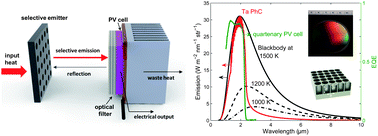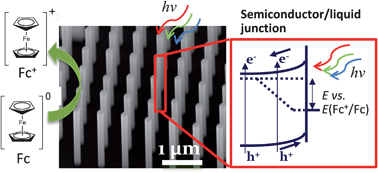Nanophotonic concepts, ranging from photonic crystals to nanowire arrays, are of tremendous interest in both solid state and photoelectrochemical (PEC) energy conversion devices.
Rinnerbauer et al, in 2012, presented a review on an emerging direction in photonics, high-temperature nanophotonics using large area 2D metallic photonic crystals aimed at solid-state energy conversion. Recently, Hu et al have shown impressive optical results in GaAs nanowire array photoanodes (for PEC devices) that occupy <5% of the fractional area of the electrode, due to efficient incoupling into the resonant waveguide modes. Despite the differences in their intended application, both papers share a common theme: use of fundamental yet scalable nanophotonic concepts in energy conversion.


Nanophotonic device design certainly has a big role in the future of energy-conversion. A variety of schemes have been proposed and demonstrated in both solid state and PEC systems and these papers represent critical steps in nanophotonic energy conversion.
By Prineha Narang
Read the papers here:
Recent developments in high-temperature photonic crystals for energy conversion
Veronika Rinnerbauer, Sidy Ndao, Yi Xiang Yeng, Walker R. Chan, Jay J. Senkevich, John D. Joannopoulos, Marin Soljacic and Ivan Celanovic
DOI: 10.1039/c2ee22731b
Optical, electrical, and solar energy-conversion properties of gallium arsenide nanowire-array photoanodes
Shu Hu, Chun-Yung Chi, Katherine T. Fountaine, Maoqing Yao, Harry A. Atwater, P. Daniel Dapkus, Nathan S. Lewis and Chongwu Zhou
DOI: 10.1039/c3ee40243f
Interested in photonics research? See our collection of articles on photonics that are free to access for a limited time here.










